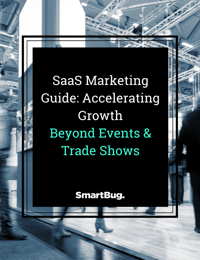-1.jpeg?width=1180&name=Product%20Messaging%20for%20SaaS%20Marketers%20(1)-1.jpeg)
Persona-Centric Product Messaging for SaaS Marketers
September 29, 2020
For SaaS marketers, product messaging is incredibly important to the success of your product marketing, from big strategic moves to the many 15-minute marketing activities you do on a day-to-day basis. SaaS product messaging needs to help you give a clear description of your tech, who you serve, and the benefits you can provide.
Sounds simple enough!
But one challenge SaaS marketers have is demonstrating the right features to the right persona to show the highest value. With so much competition and an increasingly tech-savvy population, generic product messaging just won’t do.
For example, your workout app may be a good fit for working parents, college athletes, people looking to lose weight, people looking to gain weight, seniors looking to improve their strength and mobility—you name it. For my B2B readers, your solution may solve major problems for creative freelancers, project managers, marketing directors, and C-level executives. In both of these situations, your product messaging has to work double, triple, quadruple, or quintuple duty to show value to each unique person’s needs.
This is where your persona research comes into play. Having a clear understanding of how your ideal customers identify their problems, involve their team, and seek information from possible vendors will help you identify where to focus your product messaging.
Identifying Top Opportunities for Persona-Centric SaaS Product Messaging
Typically, when identifying opportunities for persona-centric product messaging, SaaS personas fall into the following buckets:
- The decision maker
- The influencer
- The most impacted
Let’s break this down: Decision makers are the personas with purchasing authority, but value—and even require—input from influencers. Together, decision makers and influencers choose which technology to implement based on how it will solve their needs and affect others on their team, the “impacted,” who are not involved in the buying process.
Following along the earlier B2B example, the marketing director may be the decision maker for adopting a new internal communication tool for their team, because the team is experiencing productivity and communication challenges. Someone in the IT department may be involved in the buying process as an influencer to vet whether your solution will integrate into their existing tech stack. Meanwhile, marketing coordinators, freelancers, and project managers will be affected by new technology adoption because they will be using the tool frequently.
It can be easy to hone in on the decision makers when planning your product messaging, because, well, they are the ones that make the final judgement on what SaaS solution their team adopts. However, understanding your influencers is just as important as understanding your decision makers for your SaaS product messaging.
The Influencer: Look Beyond Job Titles
Regardless of their job title, influencers have a direct line to the decision makers. While they may not be the one paying your new monthly recurring revenue (MRR), their input is valued by decision makers.
When I do persona research for product messaging, I like to get to know influencers by asking why they are an influencer. Why does the decision maker value their opinion so highly? Are they an influencer because they diagnosed a problem? Because they will be the most impacted by a technology change? Because they are more technologically savvy? Because they have more time to research possible options and pass the top candidates up to the decision maker?
The answers to these questions are not dependent on job title, but depend instead on the individual’s relationship with the decision maker and the problem they are looking to solve together.
Mapping This Information for Your Product Messaging
Once you have identified which personas will be involved in assessing your solution, you need to prioritize and map the different groups you will address with persona-centric product messaging. Use the following details to find trends and position your product accordingly:
- Their role in their organization
- Their goals and pain points
- How they will be using your software
Here are a few examples of various personas, their perspectives, and their pain points:
- Decision maker #1 is looking for a solution that demonstrates strategic benefits for the team and can show a positive return on investment (ROI). This persona may not be very interested in a deep dive on features but rather in the overall advantages your technology has provided clients.
- Decision maker #2 is relying on the influencer(s) to find a solution that replaces a tool they currently use but isn’t satisfying their needs. This persona may be looking for competitive advantage messaging.
- Decision maker #3 wants to find technology that makes the most positive impact across the organization. This could fall into digital transformation, depending on this persona’s current team and technology environment.
- Influencer #1 is looking to validate your technology and its ability to integrate with existing tools the team relies on. This persona will be looking for more technical data and implementation documentation. They can be a gatekeeper for your sale if they can’t find the information they need to advise the decision maker.
- Influencer #2 has specific feature requirements to get their job done, and done well, without disrupting their day-to-day productivity while implementing new technology. This persona may be more focused on their specific needs and ease of use.
Following Best Practices for SaaS Product Messaging
Before we jump into our checklist for your product messaging journey, there are a few best practices to keep in mind:
- Start with this framework template to make sure you check all of the boxes below, then adapt based on information your specific personas need to know:
For (your persona) who (has xyz pain point/need/opportunity), (your feature/company/product name) is a (SaaS category) that (up to three benefit statements). Unlike (primary competitor), our tools (statement of primary differentiation).
- You can’t be all things to all people. Creating persona-centric brand messaging can help you be specific and demonstrate real value, rather than making your audience dig for the key benefits they are looking for.
- It’s difficult to really nail this formula with a single cohesive message for all of your personas. Don’t shy away from creating variations of your product messaging.
- Your SaaS solution is the sum of its parts, but some parts (or features) are more beneficial than others. Remember the 80/20 rule, aka the Pareto Principle, that says 80 percent of your outcomes result from 20 percent of your efforts. Identify the key functionality (or top 20 percent of your features) that make the biggest impact for 80 percent of your personas.
Your Checklist: Product Messaging for SaaS Marketers
- Are you clear about what you are selling?
Sometimes, SaaS businesses steer away from using the word “software” to avoid sounding like customers are going to get a CD-ROM in the mail. However, out of context, terms like “solutions” can make it sound like you are a consultant or service organization rather than a technology provider. Make sure you include your company, product, or feature name and industry or product category in your product messaging. - Are you clear about who you serve?
In your product messaging, call out the persona you are targeting. Whether they are on your home page, talking to sales, or reading your blog posts, show your personas that they are in the right place. Always reference who you are talking to and what pain points you can solve for them right off the bat. An example of this is the phrase, “For team leaders who want to facilitate better communication and increase productivity.” - Do your features and benefits messages align with your persona’s pain points?
In your product messaging, look for a 1:1 correlation between the pain points you reference for your specific persona and the benefit statements about your technology. Demonstrate how your software can bring value to that specific individual. If you need help, try starting with this format before trying to build your full message: persona pain point → how we solve it - Do you demonstrate value over your competitors?
If your persona is exploring your technology, they are likely also researching your competitors. Use your product messaging to show what makes you the best fit for your persona. If you took your company name out of your product messaging, would it still stand out or would it sound like other tools in your SaaS category? - Is your product messaging shared with your support, product development, marketing, and sales teams?
All of your teams should regularly reference your product messaging to validate its authenticity through the entire Buyer’s Journey, from awareness to delight. Before starting a new marketing campaign, sales kickoff, support initiative, or product development sprint, ask yourself if this project supports your personas and the message you want to uphold.

About the author
Molly Rigatti was formerly an Inbound Marketing Strategist in Charlotte, NC. With the help of her mini Aussie, Remington, she is dedicated to helping businesses reach their goals through inbound marketing and sales enablement campaigns. She's helped businesses in many different industries around the country and enjoys the challenge of staying up-to-date on all things HubSpot. Read more articles by Molly Rigatti.









